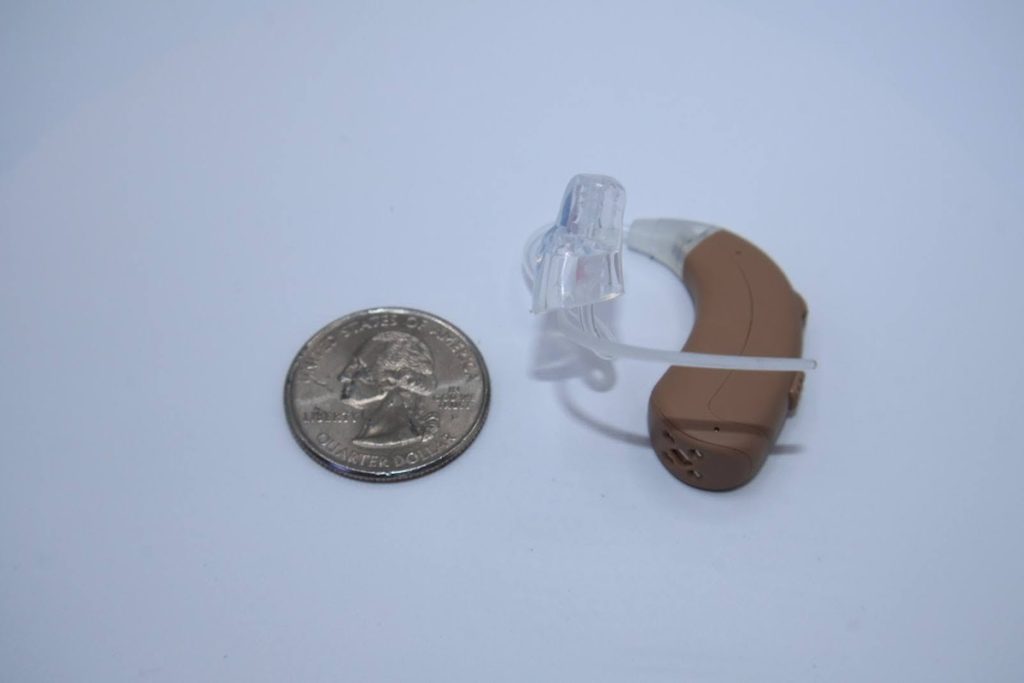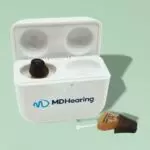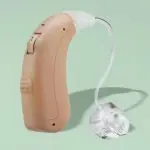Table of Contents
- We spent over 7,500 hours researching dozens of hearing aids and using a 25-question checklist to identify standout contenders. Then, our team personally tested 27 of the most popular and highly rated devices.
- We’ve interviewed 26 real hearing aid users and consulted with 17 experts to learn about which features are important when choosing a hearing aid.
- We conducted a thorough and hands-on testing process, evaluating setup and adjustment, comfort and fit, sound quality and performance, battery life and charging, ease of use, and manual and support.
- Learn more about how we tested MDHearing.
Key takeaways
- We recommend MDHearing due to its affordability and ease of use.
- Our top pick from the MDHearing lineup is the MDHearing NEO XS. It combines affordability with essential features like four hearing modes, rechargeable batteries, wireless charging in a portable charging case, and a discreet design.
- Prices start at $297 per pair.
- A standout feature of MDHearing is its affordable, direct-to-consumer model, which provides high-quality hearing aids at a fraction of the cost of traditional prescription hearing aids.
- Through surveys and testing, we determined important factors to consider when choosing an over-the-counter (OTC) hearing aid, including pricing, type of hearing aid, available features, and ease of use.
Roughly 48 million adults in the United States have some degree of hearing loss. Age-related hearing loss is one of the leading causes of disability in the United States, and untreated hearing loss can lead to social isolation, depression, and anxiety.
Unfortunately, as many as 80 percent of people who could benefit from hearing aids do not use them. Some reasons people may choose not to use hearing aids include cost, doubts about their effectiveness, and the social stigma surrounding hearing loss and the use of hearing aids.
To address the high cost of prescription hearing aids, companies like MDHearing offer over-the-counter (OTC) hearing aids at a lower cost than prescription hearing aids. MDHearing sells several different models, each with unique designs and features. We tested these models to compare each one’s performance, ease of use, comfort, and affordability to other OTC hearing aids.
In our MDHearing review, we’ll explain our findings and outline the differences between each model so you can decide if an MDHearing hearing aid is the best hearing aid for you.
Pros and cons of MDHearing aids
Pros:
- Low starting price of just $297.
- Provides basic hearing support for people with mild to moderate hearing loss.
- Offers discreet hearing aid options for those who prefer a less noticeable device.
- Rechargeable batteries eliminate the need for frequent battery replacements.
Cons:
- MDHearing hearing aids lack some of the advanced features found in more expensive devices, such as Bluetooth connectivity and app compatibility.
- Our testers reported difficulties adjusting the volume when the hearing aid was in their ear due to the small and difficult-to-press buttons.
- These hearing aids may not provide adequate hearing support for people with more severe hearing loss.
Our experience with MDHearing aids
MDHearing NEO highlights
Insights from our MDHearing NEO testers
At $297, the MDHearing NEO is one of the most affordable hearing aids on the market. However, its lower price does come with some downsides. Our testers find it difficult to turn on the NEO and adjust the volume when the device is in their ear. They also note you have to change the volume of each hearing aid separately, and only one hearing mode is available.
Despite the difficulties adjusting the volume, our testers like the device’s small size and note it feels comfortable in the ear. Our Handbook Team also thinks the user manual is helpful and easy to understand.
Who may like MDHearing NEO: Beginner users with good dexterity who don’t want an app-compatible hearing aid.
Who may want to avoid MDHearing NEO: People looking for a hearing aid with additional features, such as different hearing modes, and older adults with limited dexterity
From our tester
“It’s hard to turn on and adjust volume when the devices are in the ear. The button is tiny, and you have to press hard.”

MDHearing AIR highlights
Insights from our MDHearing AIR testers
The AIR is MDHearing’s lowest-priced BTE hearing aid. However, our testers say there’s whistling while inserting and removing the AIR. While the manual suggests removing the tubing if whistling occurs, our testers could not do so to troubleshoot the issue. They also note that the charger is difficult to use.
This model would be ideal for an individual with mild hearing loss, since the amplification would be limited due to its susceptibility to feedback.
Shelley Singh, an audiologist based in Raleigh, North Carolina
Despite some negatives, the Handbook Team likes that you can change the AIR’s hearing modes and finds the user manual thorough and helpful. They also like that the ear domes are easy to change. They feel the AIR is comfortable in the ear, although they note it is slightly heavier than some other brands tested.
Additionally, the MDHearing AIR is the only model that integrates telecoil technology. This allows the hearing aid to connect to assistive listening systems (ALS) in environments with hearing loops, such as movie theaters and places of worship. The telecoil also functions like a wireless antenna during phone calls.
Who may like MDHearing AIR: People looking for an affordable, behind-the-ear hearing aid and people with mild hearing loss.
Who may want to avoid MDHearing AIR: People looking for a more advanced user-friendly experience.
From our tester
“The AIR was comfortable in the ear; a little heavier and bulkier than others.”

MDHearing VOLT highlights
Insights from our MDHearing VOLT testers
Overall, our testers found the MDHearing VOLT a decent basic option. Since it only comes with four preset hearing modes, some people may want a hearing aid with more customization. But hearing aids with more advanced features also cost more.
Our testers appreciate the VOLT’s Quick Start Guide with clear setup instructions. However, it was initially unclear that the volume button also acts as the on/off button. Other than that, our testers feel the setup is intuitive.
Our testers note that the stabilizer bar is easy to adjust and that the VOLT is comfortable in their ears. A small button on the device lets you change hearing modes and volume. A series of beeps lets you know which mode you’re changing to, but changing the mode and volume is somewhat difficult since the buttons are small.
Who may like MDHearing VOLT: People looking for a basic behind-the-ear hearing aid with long battery life, simple setup, and multiple hearing modes.
Who may want to avoid MDHearing VOLT: Those who prefer hearing aids with app compatibility, easier controls, and more customization options.
From our tester
“Some users may want more control over customization options—you only get four presets to cycle through.”

MDHearing NEO XS highlights
Insights from our MDHearing NEO XS testers
Our Handbook Team rates the NEO XS as one of the best invisible hearing aids. Our testers like that the user manual has helpful diagrams and details, but the setup instructions don’t start until page 15.
Our testers like that the device is much smaller than other devices we’ve tested, making it a great choice for people looking for a discreet hearing aid. However, as the model’s manual notes, in-the-ear hearing aids may not fit everyone due to differences in the shape and size of ear canals, making the 45-day trial period helpful for people who want to make sure the hearing aids are the right fit.
We especially liked the “smart start” feature when you take a hearing aid out of the charging case. They automatically turn on but delay making any sound for five seconds, giving you a chance to put it in your ear and minimizing crackling or whistling sounds while you try to fit it. They also like that the charging case can fully charge the hearing aids up to six times without being plugged in, with a full charge lasting 18 hours.
Although the user manual explains this, our testers find it difficult to place the device in their ear canal properly and have to resort to trial and error. They also have trouble differentiating between low pitches (to indicate changes to the hearing mode) and high pitches (to indicate volume changes). Since the controls are small, people with dexterity issues may need help managing these hearing aids.
Who may like MDHearing NEO XS: People looking for a small, discreet, CIC-style hearing aid with an intuitive setup and a smart start feature.
Who may want to avoid MDHearing NEO XS: People with small ear canals or low dexterity.
From our tester
“The size is nice for those who want a discreet device.”

How much does MDHearing cost?
Two of the MDHearing models cost just $297, while the brand’s other two models cost $397, making them some of the most affordable hearing aids on the market.
While Jabra Enhance hearing aids are our number one pick, they are significantly more expensive than MDHearing hearing aids. However, Jabra is a good alternative to prescription hearing aids because the brand’s models offer more advanced features and good sound quality. Eargo hearing aids are also significantly more expensive than MDHearing, which makes MDHearing a better option for those on a budget.
Is MDHearing covered by insurance?
While many private insurance plans and Medicare Advantage may offer some hearing aid coverage, traditional Medicare Parts A and B do not typically provide coverage. You may be able to offset the cost if you have a health savings account (HSA) or flexible spending account (FSA), but talk to your provider about coverage under your plan.
How to save money on MDHearing
You can save money on MDHearing hearing aids by buying them as a set rather than individually. For example, while the MDHearing NEO model costs $297 for the pair, it costs $499.99 for a single hearing aid.
MDHearing has also partnered with Affirm to provide financing options. When you check out, select Affirm, and you can make monthly payments over the course of three, six, or 12 months. Rates start at zero percent APR (subject to eligibility). Click here to learn more about Affirm.
MDHearing’s online hearing test
The MDHearing online hearing test is one of our picks for the best online hearing tests due to its easy-to-understand results. To take the test, you must provide your email address to create an online profile.
You need to wear headphones or earbuds and complete the test in a quiet environment. Six different tones are used in each ear, and you’re asked to identify the softest volume you can hear for each tone.
The results page has a section with a phone number and details about how to connect with MDHearing’s audiologists to discuss your results. Once you complete the test, you will see an audiogram A graph showing the softest sounds you can hear. that you can save to your computer. Your level of hearing loss receives a label as one of the following: Healthy, Mild, Moderate, Severe, or Profound. It’s important to note that a hearing test is not needed to purchase an OTC hearing aid, but it is highly recommended. A hearing test will allow you to see your level of hearing loss, which is critical for finding the right hearing aid and ensuring safe levels of amplification.
MDHearing Mobile App
Currently, the MDHearing mobile app is only compatible with the VOLT MAX, which is frequently out of stock and has limited availability. During a conversation with customer service, we were told it’s being discontinued. The app is available for iPads and iPhones with iOS version 10 and higher or for Android devices using version 8 or higher.
If you can get the VOLT MAX and use the app, you’ll want to connect your hearing aids once you log into the app. If they do not have a full battery, place the aids in the charger for a full charge. Next, set up your device following the instructions in the app. After setting up your hearing aids, you can personalize your profile.
The MDHearing app has a dashboard that provides information about your battery levels and allows you to change your program and volume settings. An MDHearing specialist can also adjust sound settings for you through the app. To do so, click the “Support” tab at the bottom of the screen.
The app also has a “Find My Device” tool for locating lost hearing aids. This tool is located under the “Settings” tab at the bottom of the screen.
Our testing experience
With FDA approval, the OTC hearing aid market experienced rapid growth with an influx of new companies. While this improves accessibility and helps drive down prices, it also muddies the waters. How do you know which products are trustworthy?
When choosing hearing aids to test, we survey the market, interview hearing health experts, and speak to real hearing aid users. To date, we’ve curated a list of 21 OTC models to test from nine brands: Audien, Audicus, Eargo, Go Hearing, Jabra Enhance, Lexie, Lucid, MDHearing, and Sony. We chose these brands because they have positive reputations and represent a range of prices, styles, and features.
We also tested prescription models from Oticon, Phonak, and Starkey to experience the difference between OTC and Rx (prescription) hearing aids firsthand.
The process looked like this:
Our testers try multiple devices and answer 25 questions about each. We use these answers to look for outstanding performers. For example, the clarity of the Jabra Enhance Select 200 immediately catches our testers’ attention like no other OTC hearing aid.
From our tester
“Jabra Enhance Select 200 has great sound quality for different environments. I can really tell the difference between the listening programs.”
We also look for hearing aids that demonstrate consistent quality in fundamental features, like sound clarity, setup, comfort, and ease of use. Brands that don’t meet those standards didn’t make it onto our best-of list.
No brand’s hearing aids perform flawlessly. For example, one of our testers runs into trouble right away with the MDHearing Volt: the Quick Start Guide doesn’t explain how to turn it on.
We also complete onboarding calls with brand audiologists and talk with customer service representatives over the phone and through chat modules to accurately replicate the buying process and evaluate post-purchase support options.
Finally, we continue our testing by interviewing independent audiologists, hearing instrument specialists, mental health experts, and hearing aid users to get additional perspectives on OTC hearing aids.
The case for OTC hearing aids is particularly compelling. Being able to reach a wider population by increasing accessibility, simplifying the ease of fitting, and reducing the cost barriers … opens the gateway to an array of possibilities [previously inaccessible] due to exorbitant costs and lack of insurance coverage
Shelley Singh, AuD
Compare MDHearing hearing aid models
| Cost per pair | $297 | $297 | $397 | $397 |
| Type of hearing aid | In-the-canal | Behind-the-ear | Behind-the-ear | Completely-in-canal |
| Battery type | Rechargeable | Rechargeable | Rechargeable | Rechargeable |
| Bluetooth | No | No | No | No |
| Mobile app | No | No | No | No |
| Waterproof | No | No | No | No |
| Telecoil | No | No | No | No |
Compare MDHearing aids to other brands
| Cost per pair | Starting at $297 | Starting at $995 | Prescription model—pricing varies by clinic | Starting at $729 |
| Type of hearing aid | In-the-canal or behind-the-ear | Receiver-in-the-canal | Behind-the-ear, receiver-in-the-canal, in-the-canal, extended wear | In-the-canal |
| Battery type | Rechargeable | Rechargeable | Rechargeable and disposable | Rechargeable |
| Bluetooth | No* | Yes | Yes | Yes |
| Mobile app | No* | Yes | Yes | Yes |
| Waterproof | No* | No, (water-resistant) | Yes (Audéo Life is waterproof); other models are water-resistant | No, (water-resistant) |
| Telecoil | Yes, in AIR | No | Only certain models (Audéo L-RT) | No |
*These features are only available in the MDHearing VOLT MAX, which is being discontinued.
Amy Sarow, audiology lead at Soundly, says several factors should be considered when choosing a hearing aid. “When selecting a hearing aid, patients should consider their communication needs, dexterity level, Bluetooth connectivity, phone compatibility, and suitability for their degree of hearing loss.” While some people like to use a smartphone app to adjust their hearing aid volume and mode, others prefer to keep it simple and not use an app.
Shelley Singh, an audiologist in Raleigh, North Carolina, agrees. “Technical competence is also a factor that influences the ability to use advanced features which at times is determined by age but other times by personal preference,” she says.
If you decide to purchase a hearing aid online, Sarow recommends choosing a reputable brand with FDA approval. She notes that it’s also important to find out about the return period, trial period, and warranty before purchase.
Our final verdict on the MDHearing hearing aids
MDHearing hearing aids are a budget-friendly option for people seeking basic, reliable hearing aids. With prices starting at $297 per pair, they’re more affordable than other OTC hearing aids. They offer in-the-canal and behind-the-ear styles, all of which feature rechargeable batteries. However, MDHearing hearing aids lack some advanced features that may be important to certain users, and some users report difficulty adjusting the volume and mode.
Our favorite things about the MDHearing hearing aids
One of our favorite things about MDHearing hearing aids is their affordability. They are some of the most affordable hearing aids on the market, and with a starting price of $297 for a pair, they’re far more accessible to people on a budget compared to other OTC hearing aids. We also love that they come with rechargeable batteries, which are convenient and cost-effective over time.
The Handbook Team also appreciates the easy setup, intuitive controls, and helpful user manuals. In addition, the MDHearing NEO and NEO XS are notable for their small size and comfortable fit, making them a great choice for those looking for a discreet hearing aid.
Overall, MDHearing hearing aids are a good choice for first-time users or those looking for a simple, cost-effective solution without the need for high-tech features. They’re also a good option for people who live in more rural areas that don’t have local access to an audiologist. The Handbook Team feels that they are comfortable and easy to set up, but they may not be suitable for those looking for more customization or advanced features.
Our MDHearing hearing aid complaints
While we love the affordability of MDHearing hearing aids, there were some downsides. Most MDHearing hearing aids lack Bluetooth connectivity, telecoil, or app compatibility, which may be a drawback for users looking for more advanced features. While the VOLT MAX offers Bluetooth connectivity and app compatibility, it is frequently out of stock and only available in limited quantities. MDHearing does not currently offer another app-compatible model.
Additionally, our testers report difficulty adjusting the volume and switching modes, particularly on the NEO and VOLT models, due to the small and hard-to-press buttons. This could be particularly bothersome for people with limited dexterity or memory issues.
Frequently asked questions
Our testing experience reveals that MDHearing is a reliable company. They have been registered with the FDA since 2009. Their hearing aids are affordable and offer various models catering to different preferences, including in-the-canal and behind-the-ear styles. They are simple to use, making them suitable for first-time hearing aid users who may not want or need advanced features. They also offer a 45-day trial period with a 100 percent money-back guarantee if you return the device during the trial period. Finally, MDHearing hearing aids are covered against defects in materials and workmanship for one year from when you receive your order. Although the warranty does not cover any loss or damage.
Based on our experience with MDHearing, inexpensive hearing aids can be effective for people who need basic hearing assistance. However, they may not offer the advanced features or customization that more expensive models provide.
While we like MDHearing as a good basic and affordable option, The Handbook Team chooses Jabra Enhance as their number one hearing aid due to its high-quality sound technology, ease of use, comfort, customer service, and Bluetooth connectivity.
The batteries in MDHearing’s rechargeable hearing aids have a four-to-five-year lifespan.
- Jayakody, D. M. P., Wishart, J., Stegeman, I., Eikelboom, R., Moyle, T. C., Yiannos, J. M., Goodman-Simpson, J. J., & Almeida, O. P. (2022). Is There an Association Between Untreated Hearing Loss and Psychosocial Outcomes? Frontiers in Aging Neuroscience, 14, 868673. Link
- Wallhagen M. I. (2010). The stigma of hearing loss. The Gerontologist, 50(1), 66–75. Link
- Research and Markets. (2023). Over-The-Counter (OTC) Hearing Aids Market Size, Market Share, Application Analysis, Regional Outlook, Growth Trends, Key Players, Competitive Strategies and Forecasts-2023 to 2031. Link














